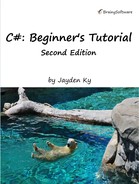0%
27Chapters
0-1Hours read
0kTotal Words
Book Description
Designed as a beginner's tutorial to the latest version of C#, this informative guide discusses the most important features of the language and teaches how to use .NET Framework. Written with clarity and readability in mind, it introduces important programming concepts and explains the process of building real-world applications, both desktop and web-based. With the most comprehensive coverage possible in a book for beginners, it includes such topics as C# language syntax, object-oriented programming, working with numbers and dates, error handling, input output, generics, annotations, LINQ, lambda expressions and WPF.Table of Contents
- Introduction
- Chapter 1: Your First Taste of C#
- Chapter 2: Language Fundamentals
- Chapter 3: Statements
- Chapter 4: Objects and Classes
- Chapter 5: Core Classes
- Chapter 6: Inheritance
- Chapter 7: Structures
- Chapter 8: Error Handling
- Chapter 9: Numbers and Dates
- Chapter 10: Interfaces and Abstract Classes
- Chapter 11: Polymorphism
- Chapter 12: Enumerations
- Chapter 13: Generics
- Chapter 14: Collections
- Chapter 15: Input/Output
- Chapter 16: Advanced Language Features
- Chapter 17: Data Access with LINQ
- Chapter 18: Windows Presentation Foundation
- Chapter 19: Multithreading
- Appendix A: Visual Studio Community 2015
- Appendix B: SQL Server 2014 Express
